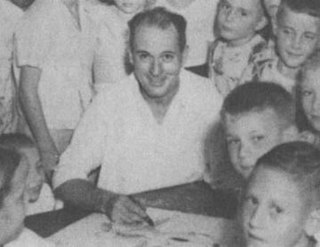
Charles Alfred "Al" Taliaferro, was an American Disney comics artist who produced Disney comic strips for King Features Syndicate. Taliaferro is best known for his work on the Donald Duck comic strip. Many of his strips were written by Bob Karp.
Silly Symphony is an American animated series of 75 musical short films produced by Walt Disney Productions from 1929 to 1939. As the series name implies, the Silly Symphonies were originally intended as whimsical accompaniments to pieces of music. As such, the films usually did not feature continuing characters, unlike the Mickey Mouse shorts produced by Disney at the same time. The series is notable for its innovation with Technicolor and the multiplane motion picture camera, as well as its introduction of the character Donald Duck making his first appearance in the Silly Symphony cartoon The Wise Little Hen in 1934. Seven shorts won the Academy Award for Best Animated Short Film.
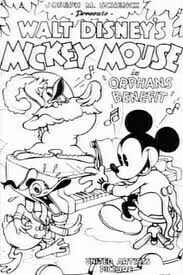
Orphan's Benefit is an American animated short film produced by Walt Disney Productions in black-and-white. It was first released in 1934 and was later remade in Technicolor in 1941 under the corrected title Orphans' Benefit. The cartoon features Mickey Mouse and his friends putting on a vaudeville-style benefit show for a group of unruly orphans. It contains a number of firsts for Disney, including the first time in which Mickey Mouse and Donald Duck appear together, and was the 68th Mickey Mouse short film to be released, and the sixth of that year. It was also the cartoon which had the first story to be written that featured Donald Duck, though it was the second Donald Duck short to be produced and released, after The Wise Little Hen.
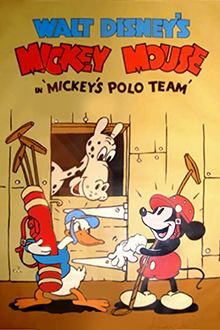
Mickey's Polo Team is a 1936 American animated short film produced by Walt Disney Productions and released by United Artists. The cartoon features a game of polo played between four Disney characters, led by Mickey Mouse, and four cartoon versions of real-life movie stars. It was directed by David Hand and was first released on January 4, 1936. The film was inspired by Walt Disney's personal love of polo. It was the 80th Mickey Mouse short film to be released, and the first of that year.

Donald's Nephews is a 1938 Donald Duck animated cartoon which features Donald being visited by his three nephews, Huey, Dewey, and Louie. This cartoon is Huey, Dewey, and Louie's first appearance in animation. Al Taliaferro, the artist for the Silly Symphony comic strip, proposed the idea for the film, so that the studio would have duck counterparts to Morty and Ferdie Fieldmouse, the nephews of Mickey Mouse. The Walt Disney Productions Story Dept. on February 5, 1937 sent Taliaferro a memo recognizing him as the source of the idea for the planned short.
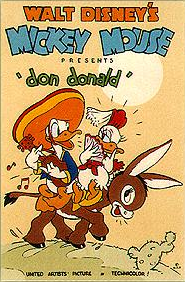
Don Donald is a 1937 American animated short film produced by Walt Disney Productions and released by United Artists. The cartoon follows Donald Duck attempting to woo a female Mexican duck named Donna. It was directed by Ben Sharpsteen and features music by Paul J. Smith which was adapted from the Mexican folk songs "Cielito Lindo" and "Jarabe Tapatío". Clarence Nash voiced both Donald and Donna.
The first wave of Walt Disney Treasures was released on December 4, 2001. It includes four different DVD sets.

Mother Goose Goes Hollywood is a 1938 animated short film produced by Walt Disney Productions and distributed by RKO Radio Pictures. The short was released on December 23, 1938. The film parodies several Mother Goose nursery rhymes using caricatures of popular Hollywood film stars of the 1930s. The film was directed by Wilfred Jackson and was the third-to-last Silly Symphony produced.
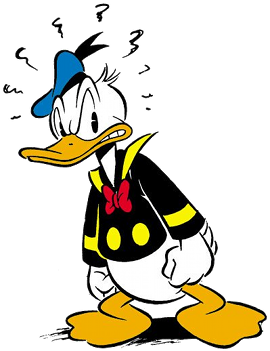
Donald Duck is a cartoon character created by The Walt Disney Company. Donald is an anthropomorphic white duck with a yellow-orange bill, legs, and feet. He typically wears a sailor shirt and cap with a bow tie. Donald is known for his semi-intelligible speech and his mischievous, temperamental, and pompous personality. Along with his friend Mickey Mouse, Donald was included in TV Guide's list of the 50 greatest cartoon characters of all time in 2002, and has earned a star on the Hollywood Walk of Fame. He has appeared in more films than any other Disney character.
The Ugly Duckling is an animated black-and-white cartoon released by Walt Disney in 1931 as part of the Silly Symphonies series. This cartoon was later remade into a color version released in 1939, which follows the original Andersen story much more faithfully. This gives The Ugly Duckling the unique distinction of being the only Silly Symphony to be made twice. This film was then sold to reach about 4,000 dollars per month at the most profit, because it slowly climbed up the scale of growth.
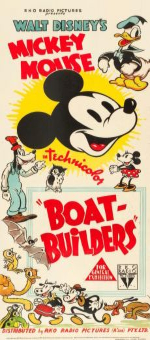
Boat Builders is an animated short film produced by Walt Disney, distributed by RKO Radio Pictures and released on February 25, 1938. The film was directed by Ben Sharpsteen and animated by Frenchy de Trémaudan, Louie Schmitt, Chuck Couch, Eddie Strickland, Clyde Geronimi, Paul Satterfield, Archie Robin, Don Patterson. It was the 99th short in the Mickey Mouse film series to be released, and the first for that year.
Mother Pluto is a Silly Symphonies cartoon released on November 14, 1936, directed by Wilfred Jackson. The cartoon features Pluto.

Mickey's Fire Brigade is a 1935 American animated short film produced by Walt Disney Productions and released by United Artists. The cartoon stars Mickey Mouse, Donald Duck, and Goofy employed as firefighters responding to a hotel fire. It was directed by Ben Sharpsteen and features the voices of Walt Disney as Mickey, Clarence Nash as Donald, Pinto Colvig as Goofy, and Elvia Allman as Clarabelle Cow. It was the 77th Mickey Mouse short to be released, and the sixth of that year.
Birds of a Feather is a Silly Symphonies animated Disney short film. It was released on February 10, 1931, by Columbia Pictures.

Farmyard Symphony is a 1938 Silly Symphonies animated short film. It can be seen as a precursor to Fantasia due to using various pieces of classical music in one short. The film was directed by Jack Cutting and produced by Walt Disney.

Mickey's Service Station is a 1935 animated short film produced by Walt Disney Productions and released by United Artists. The film, which stars Mickey Mouse, Donald Duck, and Goofy as car mechanics, was also the final black-and-white appearance of Donald, Goofy, and Pete and the penultimate animated black-and-white film produced by Disney after Mickey's Kangaroo which was released later the same year. It was also the first team-up of the classic trio of Mickey, Donald, and Goofy. Mickey's Service Station was directed by Ben Sharpsteen, who at the time had directed only Silly Symphony shorts, and starred the voices of Walt Disney, Clarence Nash, Pinto Colvig, and Billy Bletcher. It was the 74th Mickey Mouse short film to be released, and the third of that year.
The Fox Hunt is a 1938 animated short film produced by Walt Disney Productions and released by RKO Radio Pictures. The film stars Donald Duck and Goofy on a traditional English fox hunt. Mickey and Minnie Mouse, Horace Horsecollar, and Clara Cluck also make brief cameos. The film was directed by Ben Sharpsteen and features the voices of Clarence Nash as Donald and Pinto Colvig as Goofy.
Golden Eggs is a 1941 American animated short film directed by Wilfred Jackson and produced by Walt Disney, featuring Donald Duck.
Silly Symphony, initially titled Silly Symphonies, was a weekly Disney comic strip that debuted on January 10, 1932, as a topper for the Mickey Mouse strip's Sunday page. The strip featured adaptations of Walt Disney's popular short film series, Silly Symphony, which released 75 cartoons from 1929 to 1939, as well as other cartoons and animated films. The comic strip outlived its parent series by six years, ending on October 7, 1945.

Donald Duck is a series of American animated comedy short films produced by Walt Disney Productions. The series started in 1937 with Donald's Ostrich and ended in 1961 with The Litterbug. The series, a spin-off of the Mickey Mouse film series, stars the titular character Donald Duck, in addition to having recurring appearances by previously known characters such as Pluto and Pete, and also introduced well-known characters such as Donald's nephews Huey, Dewey and Louie and Donald's love interest Daisy Duck, as well as Donald's recurring rivals Chip 'n' Dale under their names.












